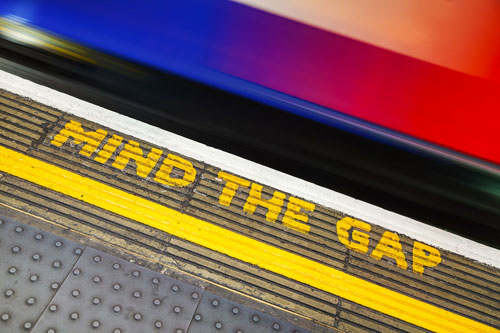Failing to meet your customer’s expectations means gaps exist in your processes. Here are some ways to fill these gaps.

Creating a great customer experience hinges on one’s ability to develop a well oiled system. Two key factors of the system are the people working within the system and the people served by the system— as both have expectations of the system. When expectations go unmet, gaps exist.
What Does the Customer Expect vs What is Provided?
When what the customer receives does not measure up to what’s expected, a gap exists. This gap may pertain to the quality of the product or the level of service provided by your company. How does one determine customer expectations? Simply ask!!
Utilize market research to get clarification on customer expectations. For example, when customers visit the post office during their lunch break, they expect to find an ample number of post office employees available to provide service at the front counter. If the majority of the post office employees themselves are on lunch break, a gap exists in the level of service the customer expects to receive vs the level of service they actually receive. Talk with key clients about their expectations.
Regularly review your customer complaints to identify what needs to be addressed within your organization. Get feedback from employees who spend the majority of their time servicing customers. The information provided by these sources will certainly identify what’s important to the customer and assist in closing the expectation gap.
Who’s Committed to Service – Delivery Quality?
Commitment to quality is paramount to creating customer experiences. When leadership is more concerned with cost reductions and short-term profits, the focus on service-delivery quality is usually not a high priority. While companies may focus on quality from an internal point of view – production schedule or production efficiency for example – the customer has no interest in the internal measurements.
What about your product or service is important to the customer? Is it the ease of operation of your product? Or maybe it’s the timeframe between ordering and receiving your product? Is it the ease to access product or service information on your website? What about the timeliness of your response to their service or product inquires? Might it be the quality of the interaction when being serviced by your company’s employees?
These are just a few measurements to consider when setting quality standards for service – delivery. Fill this gap by focusing on customer – centered measurements vs producer centered measurements. When service – delivery quality is a high priority, one can almost count on improved profits via developing loyal long-term customers.
Can You Standardize That Task?
There is a belief in the service industry, that task standardization leaves no room for the provision of a “personal experience” for the customer. There are however, routine tasks that lend themselves to standardization.
Consider the task of opening a new personal bank account. While there is a need to have a personal conversation with the new account holder, the tasks required to actually open the personal account are probably the same for each customer. Task standardization can actually help to insure that every customer receives the same level of service.
Focusing on standardization can close the gap created when the customer interacts with different service providers within your organization. When all service providers are required to adhere to the standards, the customer is the beneficiary. Are there routine tasks within your company that lend themselves to standardization?
Identifying and closing customer experience gaps within your company is critical to long-term success. Understand your customer’s expectations. Commit to the quality of service-delivery. Consider standardizing routine tasks for consistent customer interactions. Focusing on closing these gaps will prove to be one of the most profitable endeavors for your company.
About the Author
Recognized as “one of seven useful Twitter people for retailers to follow” by Mystery Shopping Experts of the UK, Customer Service Speaker, Author and Consultant Errol Allen utilizes his 25+ years of practical hands on experience to assist organizations in developing customer service strategies for maximum customer retention. Errol believes that a systems mindset is critical to an organization’s success in providing great customer experiences. Originally published as “Filling the Gaps for Better Customer Experiences”.




